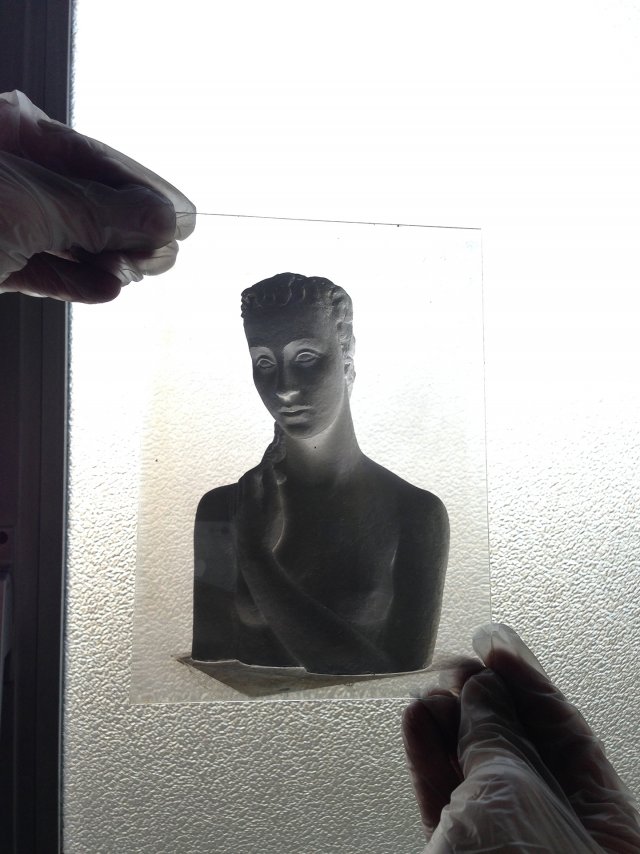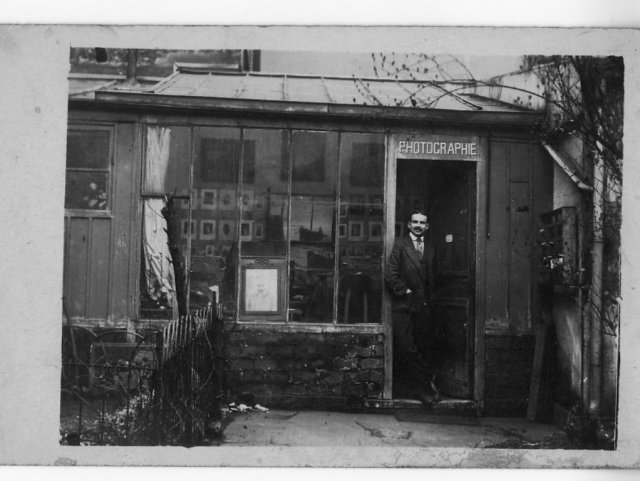Research about the Marc Vaux Archive / in collaboration with Centre Pompidou - Mnam CCI and Bibliothèque Kandinsky

- Glass plate of a Marc Vaux’s photograph of a plaster (circa 1936-1938) by Juana Muller © Centre Pompidou – Mnam – Bibliothèque Kandinsky – Fonds Marc Vaux Image : Ellie Armon Azoulay, 2015
ABOUT THE MARC VAUX ARCHIVE
Villa Vassilieff is currently developing a conversation with the Bibliothèque Kandinsky at the National Museum of Modern Art, Paris, to invite researchers and artists to engage in dialogue with the Marc Vaux Archive. Marc Vaux, a figure of Montparnasse, produced more than 250 000 photographs, which are currently held in the collection of the Centre Pompidou. They provide a new perspective on the social life of art-works and artists – famous and unknown – that he photographed between the 1930s and the 1970s. In 2016, the Centre Pompidou began undertaking the digitization of the Marc Vaux archive: a mammoth task, with many issues at stake concerning conservation and
preservation, but also historiography, museology and classification. How can one approach this archive today, in all its rich complexity? What is it in the images of Marc Vaux that considers our present?
With Didier Schulmann (Curator at the National Museum of Modern Art and Head of the Kandinsky Library), Catherine Tiraby (Archivist at the photographic collections, Bibliothèque Kandinsky), Stéphanie Rivoire (Archive Curator, Bibliothèque Kandinsky), Pat Elifritz (Candidate, CCS Bard) and Ellie Armon Azoulay (Associated Researcher, Villa Vassilieff).

- Anonymous, Marc Vaux in front of his first studio, 23 avenue du Maine, Paris, 1919 © Centre Pompidou – Mnam – Bibliothèque Kandinsky – Fonds Marc Vaux
WHO WAS MARC VAUX?
By Ellie Armon Azoulay, Virginie Bobin and Didier Schulmann
The answer to this question varies with each visit to the archive, housed in the Centre Pompidou since the photographer passed away in 1971. At first, it appears as a spectacular, perfectly structured pile of thousands of card-board boxes consisting of photographic glass plates. Family names — at times misspelled — for more than 6000 artists who were active in Paris between the early 20s and the end of the 60s whose studios Marc Vaux visited to photograph their works, have been clumsily painted with gouache in capital letters. The archive, a wall of names, of forty years of artistic creation in Paris, is a memorial of sorts. The Marc Vaux Archive unveils an archival landscape of such polyphony that one can only wonder about its author: what encyclopedic project could produce such an atlas?
Alongside some of the most well-known names amongst 20th century artists, together with other unknown names, French and otherwise, suggests that the archive contains reproductions of artworks that never made it to the walls of museums. These photographs provide a source for another art history, which encompasses a much wider community of artists than the one accessed through the eurocentric canons of institutions, cultivated aesthetic taste and the market, which still prevails in commonly shared narratives. However, beyond artists’ portraits, reproductions of artworks, studios and exhibitions photographs, the archive testifies for the artistic and political upheavals within which Paris was the stage, not unlike the displacement of artworks from the Louvre collection in 1939, under the threat of the war. A war resistant, a chronicler of the workers, Marc Vaux was committed equally to supporting artists, notably by creating the Foyer des Artistes (1946-70) and, in 1951, the first Musée du Montparnasse at 10, rue de l’Arrivée.
Despite of the richness of his archive, Marc Vaux remained a secondary character of art history, whose role transpires through discreet mentions, like in a letter written by Wilfredo Lam, who insists on the importance of Marc Vaux’s photographs to apprehend his work and prepare for his exhibitions. However, Marc Vaux’s archive shows his rigorous attention to documentation, preservation and memory, as witnessed by his note “My first photography”, on a print from 1913; and a war landscape marked with a spot where he was injured in 1915 as a soldier. Marc Vaux often re-photographed existing images, sometimes taken by others, to conserve them. He left behind 250 000 photographs: as many promises, recollections and potential readings of where to find important and significant counterpoints to the great narratives of institutions.
BIOGRAPHY - MARC VAUX
Marc Vaux was born on February 19, 1895 in Crulai, Normandy where he grew up and was trained as a carpenter. But, the First World War disrupted his life and he was drafted in December 1914. He was injured in Auberive in October 1915 and was prevented from resuming his profession [1] Discharged with disability pension, Vaux arrives to Paris and settled in 23 Avenue du Maine [2]. Encouraged by his wife [3], he began his career as a photographer. Equipped with a view camera that he kept using for the rest of his life [4], he started taking portraits of his neighbours on Avenue du Maine, as well as soldiers on leaves, notably Americans who disembarked at the Montparnasse station, but also producing large reproductions of photographs of soldiers who died in the front for their families. In 1918, he captured the bursts of joy in Place de la Concorde and sold the prints for few centimes [5].
Thanks to the color merchant from whom he bought his plates and his photographic equipment, he met the sculptor Charles Desvergnes winner of Prix the Rome and author of various memorials who was looking for someone to photographs his works. The first photographs made by Marc Vaux were of Desvergnes’s sculptures that he liked very much. Moreover Desvergnes continued to work with Marc Vaux and recommended him to his fellow artists [6]. Two of Marc Vaux’s first clients were his neighbors of 21 Avenue du Maine- Marie Vassilieff and Maria Blanchard [7] who introduced him to Parisian avant-garde artists: Juan Gris, André Lhote, Jacques Lipchitz, Ortiz de Zarate, Jules Pascin – which he photographed his atelier after he committed a suicide in 1930. Beside the atelier and the works of art, Marc Vaux was also a photographer of exhibitions. He photographed Salon des artistes Français (exclusively), Salon des Indépendants, Salon d’Automne as well as Salon des Tuileries. In 1927 he moved to 114bis Vaugirard St., into a half-timbered home of which he rented part of to many artists [8].
In 1939 he was one of the photographers responsible of making reportage of the removal of the Louvre. During World Was II, he joined the resistance: he rented under his name a room where he hid many of the resistance fighters wanted by the Gestapo [9], and assured among other things, the development and the illegal distribution of a photograph of General de Gaulle [10].
After the war, in 1946, he opened the Foyer d’Entre Aide aux Artistes in 89 boulevard du Montparnasse [11]. Besides its function as a canteen that aids the artists with affordable meal and drink, this Foyer allowed them to exhibit their work for free. To raise money for its maintenance, Marc Vaux organized, almost each summer, The Night in Montparnasse (La Nuit de Montparnasse) in Salle Huyghens, in which the election for the most beautiful model took place. But, in 1963 the future of the Foyer was darkened over: Marc Vaux received the first expulsion order from the owner of the place, claiming that the philanthropy work decreases the rental and commercial value of the property.
The trial lasted seven years and many public figures got involved, including General de Gaulle who took the side of Paris prefecture that suggested that in 1968 the Foyer would be relocated in 107 Vercingétorix St. At last, in May 30, 1970 Marc Vaux decided to leave the premise of boulevard Montparnasse and to settle temporarily the Foyer in his own house.
In 1948, he became head of Paris-Montparnasse, a magazine that was founded in 1929 by Henri Broca, with whom he collaborated on a regular basis as a photographer. He changed its name to Montparnasse – Carrefour des arts, but this magazine only issued eight numbers before its closure in 1950 [12].
In 13 of October 1951, Marc Vaux opens the Museum of Montparnasse (Musée du Montparnasse) in 10 Arrivée St. [13], in the former location of the Académie du Montparnasse. He exhibited paintings, given by artists such as Matisse, Picasso, Modigliani, Kisling etc. but also letters and documents that will become of historical importance; like the invoice for the burial of Modigliani, Pascin’s will, and of course his own photographs. But this museum was short lived and it closed after few years, a victim of the changing neighbourhood [14].
In 25 of February 1971, Marc Vaux had an art attack in the street and died. The end of his life was overshadowed by the death of his own son, but also due the closure of the Musée du Montparnasse and his Foyer.
[1] Pierre Dufour, « 45 ans de Montparnasse dans les caves de Marc Vaux », Montparnasse, Octobre 1963, n°30, p.2.
[2] Jean-Paul Crespelle, Montparnasse vivant, Paris, Librairie Hachette, 1962, op.cit., p.180
[3] Ibid., p.179
[4] Pierre Dufour, « 45 ans de Montparnasse dans les caves de Marc Vaux », op.cit. p.2
[5] Jean-Paul Crespelle, Montparnasse vivant, op.cit., p.180
[6] Ibid. p.182
[7] Marc Vaux, comments reported in Jean-Paul Crespelle, Montparnasse vivant, op.cit., p.182
[8] Ibid., p.187
[9] Certificate by Benn addressed to Marc Vaux, made on 14 June 1962. Marc Vaux Archive, Kandinsky Library, Paris.
[10] Certificate of Pierre Bompard addressed to Marc Vaux, done in 5th of June 1962. Marc Vaux Archive, Kandinsky Library, Paris.
[11] Jean-Paul Crespelle, Montparnasse vivant, op.cit., p.190
[12] Jean-Paul Crespelle, Montparnasse vivant, Paris, op.cit. p.190
[13] Invitation card kept in Marc Vaux Archive, Kandinsky Library, Paris.
[14] Pierre Dufour, « 45 ans de Montparnasse dans les caves de Marc Vaux », op.cit. p.2
Share